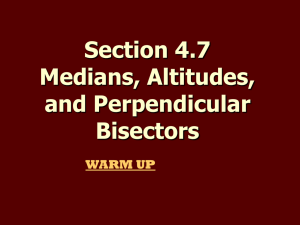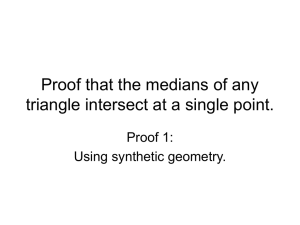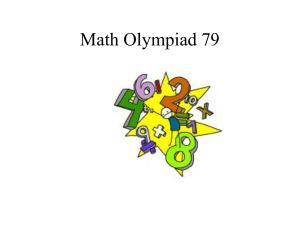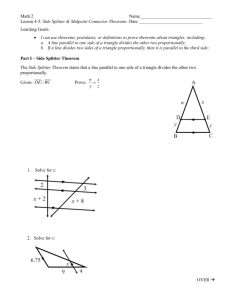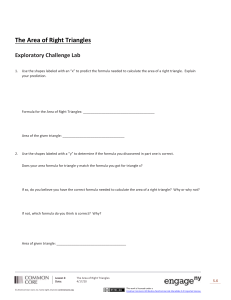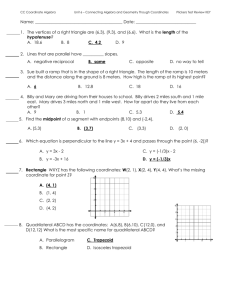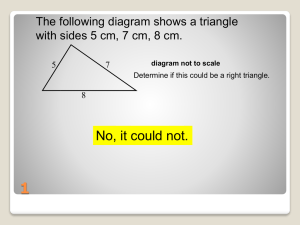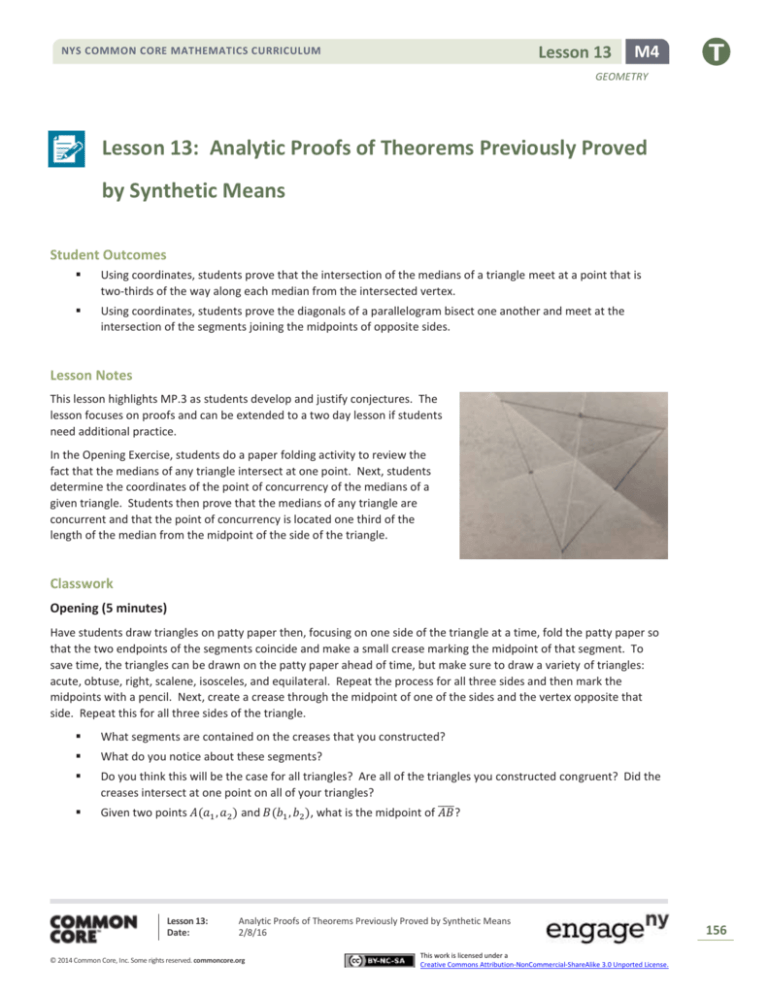
Lesson 13
NYS COMMON CORE MATHEMATICS CURRICULUM
M4
GEOMETRY
Lesson 13: Analytic Proofs of Theorems Previously Proved
by Synthetic Means
Student Outcomes
Using coordinates, students prove that the intersection of the medians of a triangle meet at a point that is
two-thirds of the way along each median from the intersected vertex.
Using coordinates, students prove the diagonals of a parallelogram bisect one another and meet at the
intersection of the segments joining the midpoints of opposite sides.
Lesson Notes
This lesson highlights MP.3 as students develop and justify conjectures. The
lesson focuses on proofs and can be extended to a two day lesson if students
need additional practice.
In the Opening Exercise, students do a paper folding activity to review the
fact that the medians of any triangle intersect at one point. Next, students
determine the coordinates of the point of concurrency of the medians of a
given triangle. Students then prove that the medians of any triangle are
concurrent and that the point of concurrency is located one third of the
length of the median from the midpoint of the side of the triangle.
Classwork
Opening (5 minutes)
Have students draw triangles on patty paper then, focusing on one side of the triangle at a time, fold the patty paper so
that the two endpoints of the segments coincide and make a small crease marking the midpoint of that segment. To
save time, the triangles can be drawn on the patty paper ahead of time, but make sure to draw a variety of triangles:
acute, obtuse, right, scalene, isosceles, and equilateral. Repeat the process for all three sides and then mark the
midpoints with a pencil. Next, create a crease through the midpoint of one of the sides and the vertex opposite that
side. Repeat this for all three sides of the triangle.
What segments are contained on the creases that you constructed?
What do you notice about these segments?
Do you think this will be the case for all triangles? Are all of the triangles you constructed congruent? Did the
creases intersect at one point on all of your triangles?
Given two points 𝐴(𝑎1 , 𝑎2 ) and 𝐵(𝑏1 , 𝑏2 ), what is the midpoint of ̅̅̅̅
𝐴𝐵 ?
Lesson 13:
Date:
Analytic Proofs of Theorems Previously Proved by Synthetic Means
2/8/16
© 2014 Common Core, Inc. Some rights reserved. commoncore.org
This work is licensed under a
Creative Commons Attribution-NonCommercial-ShareAlike 3.0 Unported License.
156
Lesson 13
NYS COMMON CORE MATHEMATICS CURRICULUM
M4
GEOMETRY
Opening Exercise (15 minutes)
In the previous lesson, students learned that given two points 𝐴(𝑎1 , 𝑎2 ) and 𝐵(𝑏1 , 𝑏2 ), the midpoint of
1
1
̅̅̅̅
𝐴𝐵 is ( (𝑎1 + 𝑏1 ), (𝑎2 + 𝑏2 )). In this exercise, students extend their knowledge of the midpoint of a segment to find
2
2
the point on each median of a given triangle that is one third of the distance from the side of the triangle to the opposite
vertex. The students will discover that this point is the same for all three sides of the triangle hence demonstrating that
not only are the medians of a triangle concurrent, they intersect at a point that divides each median into a ratio of 1: 2.
This opening exercise may be split up in several ways; each group could be given one of each type of triangle and each
work with a different vertex, or each group could be given one type of triangle and work with all vertices of that triangle.
Regardless, bring the class together in the end to discuss findings.
Opening Exercise
Let 𝑨(𝟑𝟎, 𝟒𝟎), 𝑩(𝟔𝟎, 𝟓𝟎), and 𝑪(𝟕𝟓, 𝟏𝟐𝟎) be vertices of a triangle.
a.
Find the coordinates of the midpoint 𝑴 of ̅̅̅̅
𝑨𝑩 and the point 𝑮𝟏 that is the point one-third of the way along
̅̅̅̅̅, closer to 𝑴 than to 𝑪.
𝑴𝑪
v = 50 - 40
v = 60 - 30
Midpoint is the midpoint of each
component vector.
𝟏
𝟏
𝟏
𝟏
𝑴 = (𝟑𝟎 + (𝟔𝟎 − 𝟑𝟎), 𝟒𝟎 + (𝟓𝟎 − 𝟒𝟎)) = (𝟒𝟓, 𝟒𝟓) or 𝑴 = ( (𝟑𝟎 + 𝟔𝟎),
) = (𝟒𝟓, 𝟒𝟓)
𝟐
𝟐
𝟐
𝟐(𝟒𝟎 + 𝟓𝟎)
𝟏
𝟏
𝟏
𝟏
𝑮𝟏 : (𝟒𝟓 + (𝟕𝟓 − 𝟒𝟓), 𝟒𝟓 + (𝟏𝟐𝟎 − 𝟒𝟓)) = (𝟓𝟓, 𝟕𝟎) or ( (𝟒𝟓 + 𝟒𝟓 + 𝟕𝟓), (𝟒𝟓 + 𝟒𝟓 + 𝟏𝟐𝟎)) = (𝟓𝟓, 𝟕𝟎)
𝟑
𝟑
𝟑
𝟑
Lesson 13:
Date:
Analytic Proofs of Theorems Previously Proved by Synthetic Means
2/8/16
© 2014 Common Core, Inc. Some rights reserved. commoncore.org
This work is licensed under a
Creative Commons Attribution-NonCommercial-ShareAlike 3.0 Unported License.
157
Lesson 13
NYS COMMON CORE MATHEMATICS CURRICULUM
M4
GEOMETRY
b.
̅̅̅̅ and the point 𝑮𝟐 that is the point one-third of the way along
Find the coordinates of the midpoint 𝑵 of 𝑩𝑪
̅̅̅̅, closer to 𝑵 than to 𝑨.
𝑵𝑨
𝟏
𝟏
𝟏
𝟏
𝑵 = (𝟔𝟎 + (𝟕𝟓 − 𝟔𝟎), 𝟓𝟎 + (𝟏𝟐𝟎 − 𝟓𝟎)) = (𝟔𝟕. 𝟓, 𝟖𝟓) or 𝑵 = ( (𝟔𝟎 + 𝟕𝟓),
) = (𝟔𝟕. 𝟓, 𝟖𝟓)
𝟐
𝟐
𝟐
𝟐(𝟓𝟎 + 𝟏𝟐𝟎)
𝟏
𝟏
𝟏
𝟏
𝑮𝟐 : (𝟔𝟕. 𝟓 + (𝟑𝟎 − 𝟔𝟕. 𝟓), 𝟖𝟓 + (𝟒𝟎 − 𝟖𝟓)) = (𝟓𝟓, 𝟕𝟎) or ( (𝟑𝟎 + 𝟔𝟕. 𝟓 + 𝟔𝟕. 𝟓), (𝟒𝟎 + 𝟖𝟓 + 𝟖𝟓)) = (𝟓𝟓, 𝟕𝟎)
𝟑
𝟑
𝟑
𝟑
c.
Find the coordinates of the midpoint 𝑹 of ̅̅̅̅
𝑪𝑨 and the point 𝑮𝟑 that is the point one-third of the way along
̅̅̅̅, closer to 𝑹 than to 𝑩.
𝑹𝑩
𝟏
𝟏
𝟏
𝟏
𝑹 = (𝟑𝟎 + (𝟕𝟓 − 𝟑𝟎), 𝟒𝟎 + (𝟏𝟐𝟎 − 𝟒𝟎)) = (𝟓𝟐. 𝟓, 𝟖𝟎) or 𝑹 = ( (𝟕𝟓 + 𝟑𝟎), (𝟏𝟐𝟎 + 𝟒𝟎)) = (𝟓𝟐. 𝟓, 𝟖𝟎)
𝟐
𝟐
𝟐
𝟐
𝟏
𝟏
𝟏
𝟏
𝑮𝟑 : (𝟓𝟐. 𝟓 + (𝟔𝟎 − 𝟓𝟐. 𝟓), 𝟖𝟎 + (𝟓𝟎 − 𝟖𝟎)) = (𝟓𝟓, 𝟕𝟎) or ( (𝟓𝟐. 𝟓 + 𝟓𝟐. 𝟓 + 𝟔𝟎), (𝟓𝟎 + 𝟖𝟎 + 𝟖𝟎)) = (𝟓𝟓, 𝟕𝟎)
𝟑
𝟑
𝟑
𝟑
Lesson 13:
Date:
Analytic Proofs of Theorems Previously Proved by Synthetic Means
2/8/16
© 2014 Common Core, Inc. Some rights reserved. commoncore.org
This work is licensed under a
Creative Commons Attribution-NonCommercial-ShareAlike 3.0 Unported License.
158
Lesson 13
NYS COMMON CORE MATHEMATICS CURRICULUM
M4
GEOMETRY
Discussion (2 minutes)
What are the coordinates of 𝐺1 , 𝐺2 , and 𝐺3 ?
They all have the same coordinates.
Are you surprised that all three points, 𝐺1 , 𝐺2 , and 𝐺3 , have the same coordinates?
MP.3
Most students will have expected the three medians to intersect at one point, but they may not have
known that this point is one-third of the length of each medial from each of the midpoints. Some
students may have figured this out from the opening activity.
What is true about the point of concurrency for the three medians? How do you know?
They intersect one-third of the length of the median from the midpoint as proven in the above exercises.
Do you think this is true for all triangles?
Most students will say yes because it was just shown on the last triangle. If students are not convinced,
ask them to take out their patty paper from the Opening Exercise and measure the distances.
Exercise 1 (10 minutes)
This exercise asks students to prove that the three medians of any triangle are concurrent.
They will also discover that the coordinates of the point of concurrency of the medians,
the centroid, can be easily calculated given the coordinates of the three vertices of the
triangle.
Exercise 1
a.
Given triangle 𝑨𝑩𝑪 with vertices 𝑨(𝒂𝟏 , 𝒂𝟐 ), 𝑩(𝒃𝟏 , 𝒃𝟐 ), and 𝑪(𝒄𝟏 , 𝒄𝟐 ), find the
coordinates of the point of concurrency.
Scaffolding:
This exercise can be broken
down for students with varying
levels of ability.
Give students the steps of
each example and have
them explain the steps or
fill in certain easier parts.
Talk the group through the
first example, and then
have them try the other
two on their own.
Assign the exercise as
written.
𝟏
𝟐
𝟏
𝟐
̅̅̅̅: 𝑴 = ( (𝒂𝟏 + 𝒃𝟏 ), (𝒂𝟐 + 𝒃𝟐 ))
Midpoint of 𝑨𝑩
Lesson 13:
Date:
Analytic Proofs of Theorems Previously Proved by Synthetic Means
2/8/16
© 2014 Common Core, Inc. Some rights reserved. commoncore.org
This work is licensed under a
Creative Commons Attribution-NonCommercial-ShareAlike 3.0 Unported License.
159
Lesson 13
NYS COMMON CORE MATHEMATICS CURRICULUM
M4
GEOMETRY
̅̅̅̅̅ from 𝑴:
One third of the length of 𝑴𝑪
𝟏
𝟏
𝟏
𝟏
𝟏
𝟏
( (𝒂𝟏 + 𝒃𝟏 ) + (𝒄𝟏 − (𝒂𝟏 + 𝒃𝟏 )) , (𝒂𝟐 + 𝒃𝟐 ) + (𝒄𝟐 − (𝒂𝟐 + 𝒃𝟐 )))
𝟐
𝟑
𝟐
𝟐
𝟑
𝟐
𝟏
𝟏
𝟏
𝟏
𝟏
𝟏
𝟏
𝟏
𝟏
𝟏
( 𝒂 𝟏 + 𝒃 𝟏 + 𝒄𝟏 − 𝒂 𝟏 − 𝒃 𝟏 , 𝒂 𝟐 + 𝒃 𝟐 + 𝒄𝟐 − 𝒂 𝟐 + 𝒃 𝟐 )
𝟐
𝟐
𝟑
𝟔
𝟔
𝟐
𝟐
𝟑
𝟔
𝟔
𝟏
𝟏
𝟏 𝟏
𝟏
𝟏
( 𝒂 𝟏 + 𝒃 𝟏 + 𝒄𝟏 , 𝒂 𝟐 + 𝒃 𝟐 + 𝒄𝟐 )
𝟑
𝟑
𝟑 𝟑
𝟑
𝟑
𝟏
𝟐
𝟏
𝟐
̅̅̅̅: 𝑵 = ( (𝒃𝟏 + 𝒄𝟏 ), (𝒃𝟐 + 𝒄𝟐 ))
Midpoint of 𝑩𝑪
One third of the length of ̅̅̅̅
𝑵𝑨 from 𝑵:
𝟏
𝟏
𝟏
𝟏
𝟏
𝟏
( (𝒂𝟏 + 𝒄𝟏 ) + (𝒃𝟏 − (𝒂𝟏 + 𝒄𝟏 )) , (𝒂𝟐 + 𝒄𝟐 ) + (𝒃𝟐 − (𝒂𝟐 + 𝒄𝟐 )))
𝟐
𝟑
𝟐
𝟐
𝟑
𝟐
𝟏
𝟏
𝟏
𝟏
𝟏
𝟏
𝟏
𝟏
𝟏
𝟏
( 𝒂 𝟏 + 𝒄𝟏 + 𝒃 𝟏 − 𝒂 𝟏 − 𝒄𝟏 , 𝒂 𝟐 + 𝒄𝟐 + 𝒃 𝟐 − 𝒂 𝟐 + 𝒄𝟐 )
𝟐
𝟐
𝟑
𝟔
𝟔
𝟐
𝟐
𝟑
𝟔
𝟔
𝟏
𝟏
𝟏 𝟏
𝟏
𝟏
( 𝒂 𝟏 + 𝒃 𝟏 + 𝒄𝟏 , 𝒂 𝟐 + 𝒃 𝟐 + 𝒄𝟐 )
𝟑
𝟑
𝟑 𝟑
𝟑
𝟑
𝟏
𝟏
Midpoint of ̅̅̅̅
𝑨𝑪: 𝑹 = ( (𝒂𝟏 + 𝒄𝟏 ), (𝒂𝟐 + 𝒄𝟐 ))
𝟐
𝟐
̅̅̅̅ from 𝑹:
One third of the length of 𝑹𝑨
𝟏
𝟏
𝟏
𝟏
𝟏
𝟏
( (𝒂𝟏 + 𝒄𝟏 ) + (𝒃𝟏 − (𝒂𝟏 + 𝒄𝟏 )) , (𝒂𝟐 + 𝒄𝟐 ) + (𝒃𝟐 − (𝒂𝟐 + 𝒄𝟐 )))
𝟐
𝟑
𝟐
𝟐
𝟑
𝟐
𝟏
𝟏
𝟏
𝟏
𝟏
𝟏
𝟏
𝟏
𝟏
𝟏
( 𝒂 𝟏 + 𝒄𝟏 + 𝒃 𝟏 − 𝒂 𝟏 − 𝒄𝟏 , 𝒂 𝟐 + 𝒄𝟐 + 𝒃 𝟐 − 𝒂 𝟐 + 𝒄𝟐 )
𝟐
𝟐
𝟑
𝟔
𝟔
𝟐
𝟐
𝟑
𝟔
𝟔
𝟏
𝟏
𝟏 𝟏
𝟏
𝟏
( 𝒂 𝟏 + 𝒃 𝟏 + 𝒄𝟏 , 𝒂 𝟐 + 𝒃 𝟐 + 𝒄𝟐 )
𝟑
𝟑
𝟑 𝟑
𝟑
𝟑
After part (a), bring the group back together to discuss the formulas. Name the formula after the person who presents it
most clearly— for example: We will call this “Tyler’s formula”.
b.
Let 𝑨(−𝟐𝟑, 𝟏𝟐), 𝑩(𝟏𝟑, 𝟑𝟔), and 𝑪(𝟐𝟑, −𝟏) be vertices of a triangle. Where will the medians of this triangle
intersect? (Use “Tyler’s formula” from part (a) to complete this problem.)
𝟏
𝟏
𝟏
𝟏
𝟏
𝟏
𝟏
𝟏
𝟏𝟑 𝟒𝟕
( (−𝟐𝟑) + (𝟏𝟑) + (𝟐𝟑), (𝟏𝟐) + (𝟑𝟔) + (−𝟏)) or ( (−𝟐𝟑 + 𝟏𝟑 + 𝟐𝟑), (𝟏𝟐 + 𝟑𝟔 + −𝟏)) = ( , )
𝟑
𝟑
𝟑
𝟑
𝟑
𝟑
𝟑
𝟑
𝟑 𝟑
Lesson 13:
Date:
Analytic Proofs of Theorems Previously Proved by Synthetic Means
2/8/16
© 2014 Common Core, Inc. Some rights reserved. commoncore.org
This work is licensed under a
Creative Commons Attribution-NonCommercial-ShareAlike 3.0 Unported License.
160
Lesson 13
NYS COMMON CORE MATHEMATICS CURRICULUM
M4
GEOMETRY
Exercise 2 (6 minutes)
In this exercise, students are asked to use this coordinate approach to prove that the
diagonals of a rectangle bisect each other.
Scaffolding:
You may want to provide students
with the following diagram.
Exercise 2
Prove that the diagonal of a parallelogram bisect each other.
Students will show that the diagonals are concurrent at their midpoints. Stated another
way, both diagonals have the same midpoint.
̅̅̅̅: (𝟏 (𝒃 + 𝒂), 𝟏 𝒉)
Midpoint of 𝑷𝑸
𝟐
𝟐
𝟏
𝟏
Midpoint of ̅̅̅̅
𝑸𝑺: ( (𝒃 + 𝒂), 𝒉)
𝟐
𝟐
Closing (3 minutes)
Ask students to respond to this question individually in writing, to a partner, or as a class.
How did we use coordinates to prove that the medians of any triangle will always meet at a point that is twothirds of the way along each median from the intersected vertex?
We found the point of intersection of the three medians, and then we found the point on each median
two-thirds of the way from each vertex and noticed that they were all the same. This was true for any
triangle we studied.
Exit Ticket (4 minutes)
Lesson 13:
Date:
Analytic Proofs of Theorems Previously Proved by Synthetic Means
2/8/16
© 2014 Common Core, Inc. Some rights reserved. commoncore.org
This work is licensed under a
Creative Commons Attribution-NonCommercial-ShareAlike 3.0 Unported License.
161
Lesson 13
NYS COMMON CORE MATHEMATICS CURRICULUM
M4
GEOMETRY
Name
Date
Lesson 13: Analytic Proofs of Theorems Previously Proved by
Synthetic Means
Exit Ticket
1
Prove that the medians of any right triangle form similar right triangles whose area is the area of the original triangle.
4
1
Prove the area of △ 𝐶𝑀𝑅 is the area of △ 𝐶𝐴𝐵.
4
Lesson 13:
Date:
Analytic Proofs of Theorems Previously Proved by Synthetic Means
2/8/16
© 2014 Common Core, Inc. Some rights reserved. commoncore.org
This work is licensed under a
Creative Commons Attribution-NonCommercial-ShareAlike 3.0 Unported License.
162
Lesson 13
NYS COMMON CORE MATHEMATICS CURRICULUM
M4
GEOMETRY
Exit Ticket Sample Solutions
Prove that the medians of any right triangle form a similar right triangles whose area is
Prove the area of △ 𝑪𝑴𝑹 is
𝟏
𝟒
𝟏
𝟒
the area of the original triangle.
the area of △ 𝑪𝑨𝑩.
Place the triangle on the coordinate plans as shown to the right will allow for the most
efficient algebraic solution yielding midpoints
𝟏
𝟐
𝟏
𝟐
𝟏
𝟐
𝟏
𝟐
𝑴 = (𝟎, 𝒄), 𝑹 = ( 𝒃, 𝒄), and 𝑺 = ( 𝒃, 𝟎).
𝟏
𝑹𝑴 𝟐 𝒃 𝟏
=
=
𝑨𝑩
𝒃
𝟐
̅̅̅̅̅
𝑨𝑪 and ̅̅̅̅
𝑹𝑺 are both vertical as their slopes are undefined.
̅̅̅̅̅
𝑨𝑩 and ̅̅̅̅̅
𝑹𝑴 are both horizontal as their slopes are zero.
△ 𝑨𝑩𝑪 ≅ △ 𝑹𝑴𝑺 by SAS similarity.
𝟏
𝟐
The area of △ 𝑨𝑩𝑪 = 𝒃 ∙ 𝒄.
𝟏 𝟏
𝟐 𝟐
𝟏
𝟐
𝟏 𝟏
𝟒 𝟐
The area of △ 𝑹𝑴𝑺 = ( 𝒃) ∙ ( 𝒄) = ( 𝒃 ∙ 𝒄) =
𝟏
△ 𝑨𝑩𝑪.
𝟖
Problem Set Sample Solutions
1.
Point 𝑴 is the midpoint of segment ̅̅̅̅
𝑨𝑪. Find the coordinates of 𝑴:
a.
𝑨(𝟐, 𝟑), 𝑪(𝟔, 𝟏𝟎)
(𝟒, 𝟔. 𝟓)
b.
𝑨(−𝟕, 𝟓), 𝑪(𝟒, −𝟗)
(−𝟏. 𝟓, −𝟐)
2.
𝑴(−𝟐, 𝟏𝟎) is the midpoint of segment ̅̅̅̅
𝑨𝑩. If A has coordinates (𝟒, −𝟓), what are the coordinates of 𝑩?
(−𝟖, 𝟐𝟓)
3.
̅̅̅̅ with 𝑩(−𝟐, −𝟏) and 𝑪(𝟒, 𝟏).
Line 𝑨 is the perpendicular bisector of segment 𝑩𝑪
̅̅̅̅?
a.
What is the midpoint of 𝑩𝑪
(𝟏, 𝟎)
b.
What is the slope of ̅̅̅̅
𝑩𝑪?
𝟏
𝟑
c.
̅̅̅̅.)
What is the slope of line 𝑨? (Remember, it is perpendicular to 𝑩𝑪
−𝟑
Lesson 13:
Date:
Analytic Proofs of Theorems Previously Proved by Synthetic Means
2/8/16
© 2014 Common Core, Inc. Some rights reserved. commoncore.org
This work is licensed under a
Creative Commons Attribution-NonCommercial-ShareAlike 3.0 Unported License.
163
Lesson 13
NYS COMMON CORE MATHEMATICS CURRICULUM
M4
GEOMETRY
d.
̅̅̅̅.
Write the equation of line 𝑨, the perpendicular bisector of 𝑩𝑪
𝒚 = −𝟑𝒙 + 𝟑
4.
Find the coordinates of the intersection of the medians of △ 𝑨𝑩𝑪 given 𝑨(−𝟓, 𝟑), 𝑩(𝟔, −𝟒), and 𝑪(𝟏𝟎, 𝟏𝟎).
𝟏
𝟏
𝟐
( (−𝟓 + 𝟔 + 𝟏𝟎), (𝟑 + (−𝟒) + 𝟏𝟎)) = (𝟑 , 𝟑)
𝟑
𝟑
𝟑
5.
Use coordinates to prove that the diagonals of a parallelogram meet at the intersection of the segments that
connect the midpoints of its opposite sides.
This problem builds upon the findings of Exercise 2 where
students proved that the diagonals of a parallelogram
bisected each other by showing that the midpoints of the two
𝟏
𝟐
𝟏
𝟐
diagonals occurred at the same point, ( (𝒃 + 𝒂), 𝒉).
𝟏
𝑨: Midpoint of ̅̅̅̅
𝑷𝑺 = ( 𝒂, 𝟎)
𝟐
𝟏
𝟐
̅̅̅̅ = ( (𝟐𝒃 + 𝒂), 𝒉)
𝑩: Midpoint of 𝑸𝑹
𝟏 𝟏
𝑪: Midpoint of ̅̅̅̅
𝑷𝑸 = ( 𝒃, 𝒉)
𝟐
𝟐
̅̅̅̅ = (𝟏 (𝟐𝒂 + 𝒃), 𝟏 𝒉)
𝑫: Midpoint of 𝑹𝑺
𝟐
𝟐
Finding the midpoint of the segment connecting the midpoints of ̅̅̅̅
𝑷𝑺 and ̅̅̅̅
𝑸𝑹:
𝟏 𝟏
𝟏
𝟏
𝟏
𝟏
( ( 𝒂 + (𝟐𝒃 + 𝒂)) , (𝟎 + 𝒉)) = ( (𝒂 + 𝒃), 𝒉)
𝟐 𝟐
𝟐
𝟐
𝟐
𝟐
Finding the midpoint of the segment connecting the midpoints of ̅̅̅̅
𝑷𝑸 and ̅̅̅̅
𝑹𝑺:
𝟏 𝟏
𝟏
𝟏 𝟏
𝟏
𝟏
𝟏
( ( 𝒃 + (𝟐𝒂 + 𝒃)) , ( 𝒉 + 𝒉)) = ( (𝒂 + 𝒃), 𝒉)
𝟐 𝟐
𝟐
𝟐 𝟐
𝟐
𝟐
𝟐
The segments connecting the midpoints of the opposite sides of the parallelogram intersect at their midpoints which
𝟏
𝟐
𝟏
𝟐
is located at ( (𝒂 + 𝒃), 𝒉).
6.
Given a quadrilateral with vertices 𝑬(𝟎, 𝟓), 𝑭(𝟔, 𝟓),𝑮(𝟒, 𝟎), and 𝑯(−𝟐, 𝟎):
a.
Prove quadrilateral 𝑬𝑭𝑮𝑯 is a parallelogram.
̅̅̅̅̅ are horizontal segments, so they are parallel.
̅̅̅̅ and 𝑮𝑯
𝑬𝑭
𝟓
̅̅̅̅̅
𝑯𝑬 and ̅̅̅̅
𝑮𝑭 have slopes of , so they are parallel.
𝟐
Both pairs of opposite sides are parallel, so the quadrilateral is a parallelogram.
b.
Prove (𝟐, 𝟐. 𝟓) is a point on both diagonals of the quadrilateral.
̅̅̅̅ and
Since 𝑬𝑭𝑮𝑯 is a parallelogram, the diagonals intersect at their midpoints. (𝟐, 𝟐. 𝟓) is the midpoint of 𝑯𝑭
̅̅̅̅
𝑮𝑬, so it is a point on both diagonals.
Lesson 13:
Date:
Analytic Proofs of Theorems Previously Proved by Synthetic Means
2/8/16
© 2014 Common Core, Inc. Some rights reserved. commoncore.org
This work is licensed under a
Creative Commons Attribution-NonCommercial-ShareAlike 3.0 Unported License.
164
Lesson 13
NYS COMMON CORE MATHEMATICS CURRICULUM
M4
GEOMETRY
7.
Prove quadrilateral 𝑾𝑿𝒀𝒁 with vertices 𝑾(𝟏, 𝟑), 𝑿(𝟒, 𝟖), 𝒀(𝟏𝟎, 𝟏𝟏), and 𝒁(𝟒, 𝟏) is a trapezoid.
𝟓
̅̅̅̅̅
𝑾𝑿 and ̅̅̅̅
𝒀𝒁 have slopes of , so they are parallel.
𝟑
𝟏
̅̅̅̅̅ has a slope of − 𝟐 and 𝑿𝒀
̅̅̅̅ has a slope of , so they are not parallel.
𝑾𝒁
𝟑
𝟐
When one pair of opposite sides is parallel, the quadrilateral is a trapezoid.
8.
Given quadrilateral 𝑱𝑲𝑳𝑴 with vertices 𝑱(−𝟒, 𝟐), 𝑲(𝟏, 𝟓), 𝑳(𝟒, 𝟎), and 𝑴(−𝟏, −𝟑):
a.
Is it a trapezoid? Explain.
𝟑
Yes, one pair of opposite sides is parallel. ̅̅̅̅
𝑱𝑲 and ̅̅̅̅̅
𝑳𝑴 both have slopes of .
𝟓
When one pair of opposite sides is parallel, the quadrilateral is a trapezoid.
b.
Is it a parallelogram? Explain.
̅̅̅̅ and 𝑲𝑳
̅̅̅̅ both have slopes of − 𝟓.
Yes, both pairs of opposite sides are parallel. 𝑱𝑴
𝟑
When both pairs of opposite sides are parallel, the quadrilateral is a parallelogram.
c.
Is it a rectangle? Explain.
̅̅̅̅
̅̅̅̅, ̅̅̅̅̅
̅̅̅̅̅, 𝑴𝑳
̅̅̅̅̅ ⊥ 𝑴𝑱
̅̅̅̅, 𝑴𝑱
̅̅̅̅ ⊥ ̅̅̅̅
𝑱𝑲 ⊥ 𝑲𝑳
𝑲𝑳 ⊥ 𝑴𝑳
𝑱𝑲 because their slopes are negative reciprocals.
Yes, because a parallelogram with four right angles is a rectangle.
d.
Is it a rhombus? Explain.
𝑱𝑲 = 𝑲𝑳 = 𝑳𝑴 = 𝑴𝑱 = √𝟑𝟒
Yes, because a parallelogram with four congruent sides is a rhombus.
e.
Is it a square? Explain.
Yes, because a rectangle with four congruent sides is a square.
f.
Name a point on the diagonal of 𝑱𝑲𝑳𝑴. Explain how you know.
(𝟎, 𝟏) is the midpoint of ̅̅̅̅̅
𝑲𝑴 and ̅̅̅
𝑱𝑳 and is on both diagonals.
Lesson 13:
Date:
Analytic Proofs of Theorems Previously Proved by Synthetic Means
2/8/16
© 2014 Common Core, Inc. Some rights reserved. commoncore.org
This work is licensed under a
Creative Commons Attribution-NonCommercial-ShareAlike 3.0 Unported License.
165


